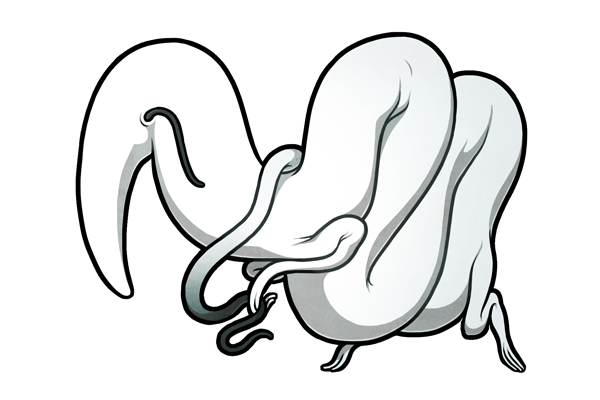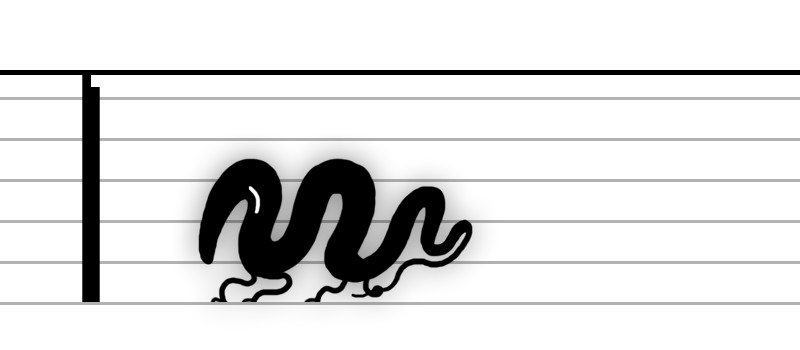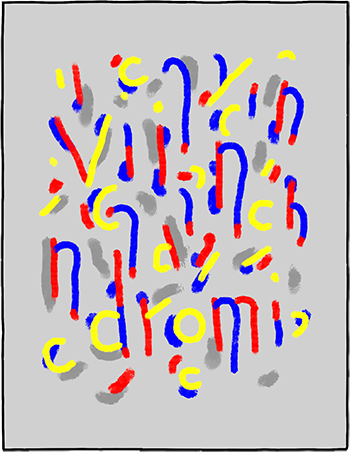

viidromi
the understudies
prefix vii suffix dromi
silvastre shoushand
physical appearance
The viidromi /ˈviːdroʊmi/ is an elongated stranger that lacks markings, save for its thin, pupil-less eyes, its darkened tail-tip, and the slight, pinkish hues that tint its palms and underbelly. Its mouth is small, with no detailing to its oral cavity (which lacks even gums or a tongue), save for a row of white, nub-like teeth. When its mouth is closed, the seam of its lips is barely visible at all. The viidromi's skin and flesh are warm and soft to the touch, like heated silicone, and it possesses no internal organs. Both its hands and feet are dainty and human-like, and despite its thin limbs, the viidromi has no difficulties holding its long body upright as it moves.
Despite the viidromi's rubbery form, it is slightly damaged by water, which causes it to dissolve into a milky fluid. While it can recover (albeit slowly) from brief contact, submersion is ultimately fatal, dissolving the viidromi in two to three hours. Otherwise, the viidromi's sturdy but flexible body makes it resistant to wear-and-tear, despite minimal regenerative abilities (taking several weeks to heal from even surface abrasions, with not all injuries healing at all).
The viidromi does not speak using discernible words, but rather, communicates through infrequent whistles. It also makes a faint breathing sound at all times, although its body does not display the rise and fall of inhalation and exhalation.
whistling that rises in pitch, but not excitement.

environment and generation
The viidromi appears in a wide range of external environments, but prefers modern cities with a high quality of life, low levels of dirt and decay, and frequent upkeep of buildings and infrastructure. Long, white, windowless building-sides, chain-link fences, stacks of boxes, and flat grey skies all appear to contribute to a viidromi infestation.
The viidromi first appears by emerging from a solid plane, its form mature upon materialization. Upon emergence, the viidromi's tail-tip is white, with its darker color fading in gradually over the initial part of its life. In this phase, the viidromi's movements also tend to be more aloof and lethargic, with its energy level rising as its tail-tip darkens.
behaviour and effects
The viidromi displays a demure nature. Although it tends to stay within a set area, it is prone to movement within this territory. The viidromi is an adept climber, but does not seek out high altitudes – rather, it perches on cars, dumpsters, and the tops of thick cement walls. The soft pads of its palms provide excellent grip, and the viidromi has no difficulty climbing even solid vertical surfaces when the need arises. It likes to lay in patches of sun, and grows somnolent on cloudless days.
The viidromi holds its own tail compulsively any time it sits down, and displays grooming behaviours when at rest, stroking its skin, shaking itself free of dirt, and using pools of water (which dissolves its surface) to clean off persistent stains and smudges. Because it is damaged by large volumes of water, the viidromi does seek shelter in the rain, and grows agitated when unable to find a place to hide.
Upon finding a human corpse, the viidromi lays on top of it, its own body softening like a runny egg. It remains like this until dying and dissolving completely, coating the body below with a plasticine sludge. The viidromi seems particularly content in this action.
interactions between viidromi
When two viidromi meet, they approach one another with an inevitable curiosity and merge their bodies into one. This merged viidromi takes on a physical appearance that reflects both combined unique traits of both individuals, and their mean size. The viidromi does not display any particular emotional reaction to this merging, and, because of this behaviour, no groups of viidromi have been observed.
interactions with sensitives
The viidromi displays a subtle interest towards sensitives within its environment. It is slow to approach, but is not completely avoidant, and eventually crawls over to press its head against the sensitive's hand or legs. It appears to enjoy being touched, with feather-light strokes eliciting sighs and whistles. When attacked, the viidromi appears hurt and shocked, but does not fight back. As such, it may be tempting for certain sensitives to destroy these weak and defenseless strangers.
When a sensitive touches the viidromi, any sensations caused are mirrored exactly 24 hours, 17 minutes, and 15 seconds later on their own body. Thus, a sensitive who strokes the viidromi's head feels a stroking sensation on their own head the next day, while a sensitive who causes injury to the viidromi finds themselves overcome by the unbearable pain of these wounds. This effect is not contingent on skin-on-skin contact (occurring even when the sensitive uses knives or wears gloves), but does not occur when an object is thrown at the viidromi, nor does it occur when the viidromi is shot with a bullet.
aging and death
As the viidromi ages, it displays a slow deformation correlating to the number of times it has merged with other individuals. A viidromi merged from two individuals displays a bilateral splitting of certain body segments, most often the nose, arm, tail, or leg, while a viidromi merged from more individuals deforms more radically, with separation of the jaws, the emergence of new limbs, or lengthening of the torso. Although these deformations do not cause death in and of themselves, more severe mutations do prove debilitating, leaving the viidromi pained and defenseless.
A non-merged viidromi displays no such deformation, and instead ages more gracefully, its behaviour growing more complacent and less responsive. At the end of its life, the viidromi stops moving and hardens without warning, dying with a gasping crunching sound as its flesh turns hard. This corpse takes on a crumbly, foam-like form, which, after several days, grows so brittle that even the slightest touch causes it to break apart into a powdery material. Nearby viidromi crawl towards these corpses, writhing and coiling around them, as though still trying to merge. These still-living viidromi continue to press themselves against the corpses of their companions, until their sinuations break these bodies apart to dust, which scatters in the breeze and then fades away.





